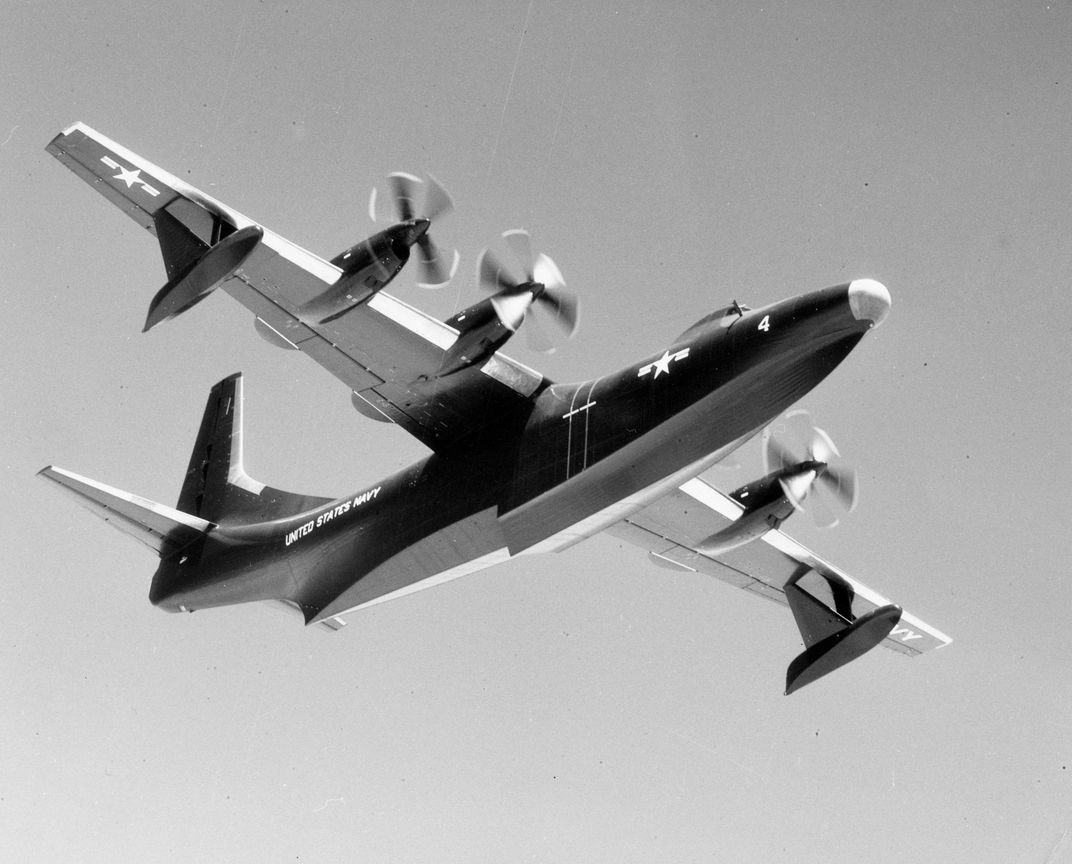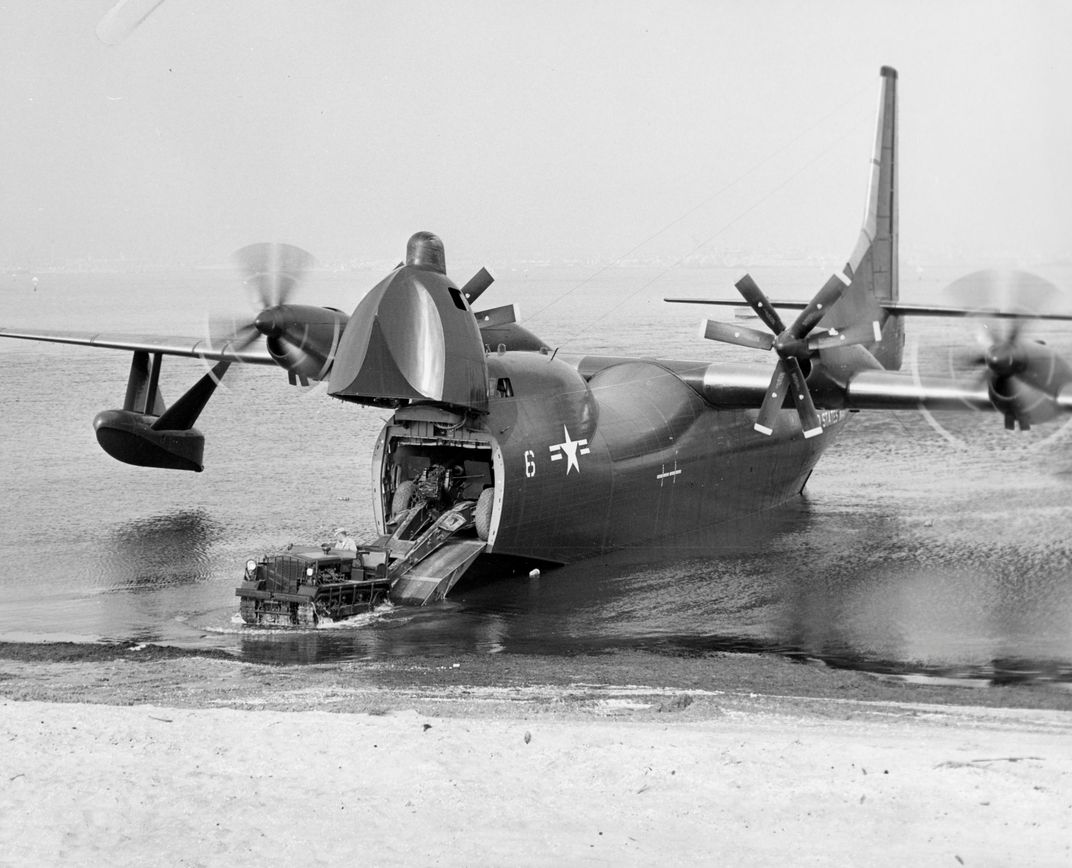Last of the Great Flying Boats
Why the Convair Tradewind was a beautiful, versatile, fast failure.
/https://tf-cmsv2-smithsonianmag-media.s3.amazonaws.com/filer/a9/13/a91351e8-000c-4fe0-bcbb-09fab857bf01/07c_fm2015_r3yandcrowd_live.jpg)
When I was a young kid obsessed with airplanes, my mom bought me a model of the Convair R3Y Tradewind flying boat. I still remember how the nose of my model hinged up just like the real thing. Despite this and other innovations, the Tradewind would prove to be the last in the company’s long line of celebrated seaplanes.
Derived from a scrubbed Navy patrol bomber, the Tradewind was an attractive airplane that would serve as a high-speed transport and aerial tanker for seaplanes based at remote locations. The four-engine turboprop featured a long thin wing mounted atop a slim hull with cabin air conditioning and pressurization.
Each of its four Allison T40-A-10 engines comprised two smaller jet power sections mounted side by side, and geared to a set of contra-rotating propellers. The 5,500-shaft-horsepower T40 was designed so that either power section was independently capable of driving the six-blade propeller assembly. Once airborne, one unit could be shut down for maximum fuel economy. Convair gave the first Tradewind a traditional ship’s christening with aquatic film star Esther Williams splashing the seaplane’s bow with waters collected from the seven seas. The Tradewind made its first flight on February 25, 1954; five were produced with the graceful “cruiser bow” configuration. This version could carry 80 troops more than 2,000 miles without refueling, or heft an impressive 24-ton payload as a cargo ship.
The following six Tradewinds were classified as assault transports and had raised flight decks and bulbous nose sections that tilted up, allowing easy roll-on/roll-off access to the fuselage cargo spaces.
Bob Johnston, an archivist at the San Diego Air & Space Museum, remembers how the Tradewind acquired its romantic name, which evoked travel to exotic places. He worked on Convair’s San Diego seaplane ramp in 1954 as a young dispatcher, and recalls the company-sponsored contest for naming the flying boat. His “also ran” suggestion, Conquistador, bagged him a Zippo lighter etched with the airplane’s silhouette. “The Tradewinds were absolutely beautiful,” says Johnston. “I loved the deep rumble of their props.”
Tradewinds began arriving at Naval Air Transport Squadron Two (VR-2) at Naval Air Station, Alameda, California, in 1956 to replace the unit’s enormous Martin Mars flying boats on Pacific routes. Lieutenant Homer Ragsdale joined VR-2 that same year, and he thought the squadron’s fortunes looked bright. An experienced flying boat captain accustomed to lumbering PBYs, Ragsdale was impressed with the Tradewind’s performance. Reversible props made the big airplane nimble on the water, and the powerful engines—initially hailed for their impressive power-to-weight ratio—enabled 350-mph dashes with climb rates comparable to those of many World War II fighters. “They were fast,” recalls Ragsdale, who lives today in Redlands, California. “You could feel the power in them.”
But the Tradewind had a flaw that would eventually lead to its demise: Its 15-foot-diameter propellers had an alarming tendency to fail in flight.
Ragsdale experienced the problem firsthand on a January 1958 night flight from Honolulu to San Francisco. He was one of the pilots at the controls of the Tradewind Indian Ocean when the number-two engine’s propeller suddenly sheared off, slashing the fuselage just forward of the left wing. “Made a hole about the size of a Volkswagen,” he says.
About 400 miles from their Alameda base, the crew pressed on to a San Francisco Bay area undergoing a winter storm. Finding a hole in the overcast, they spiraled down for an emergency landing, only to find that the number-one engine controls were cut. Once on the water, despite the pilots’ best efforts, the uncontrollable engine veered them into a seawall.
By hauling back on their control yokes just before impact, the pilots raised the nose enough to avoid a head-on collision and possible disaster; instead, the bottom of the hull absorbed the blow. With the aircraft crashed onto the seawall and the runaway engine still turning at nearly full power, the crew abandoned ship while a brave mechanic crawled into the shaking wing to manually shut down the engine.
The crippled flying boat had set a world speed record for propeller-driven transport aircraft—flying between Honolulu and San Francisco in five hours and 54 minutes—but the flight turned out to be the Tradewind’s swan song. Another Tradewind, Coral Sea, had crashed earlier, also due to a prop malfunction, and the Navy had had enough. The big flying boats were grounded.
Hoping to salvage the program, Convair proposed replacing the engines with a more reliable Rolls-Royce turboprop. Despite a critical need for tanker capabilities like those provided by the versatile Tradewinds, the Navy was unwilling to sink any more money into them. On April 16, 1958, the service ordered the 11 Tradewinds scrapped and the squadron disbanded.
What should have been the Navy’s next-generation transport flying boat barely lasted two years in service. Today, all that remains of Convair’s last big boats are, ironically, a few T40s stashed away in museums. And Johnston still has his cool Tradewind Zippo.

